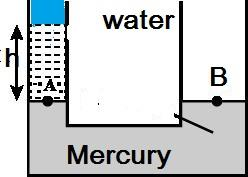
Two communicating vessels contain mercury. The diameter of one vessel is n times larger than the diameter of the other. A column of water of height h is poured into the left vessel. The mercury level will rise in the right hand vessel (s=relative density of mercury and ρ =density of water) by:

Answer
142.2k+ views
1 likes
Hint: We will follow Pascal's principle, also called Pascal's law, any force applied to a confined fluid is transmitted uniformly in all directions throughout the fluid regardless of the shape of the container.
Complete step by step solution:
If the level in narrow tubes goes down by
Option B is correct.
Additional Information: A solid surface can exert pressure, but liquids (ie liquid or gas) can also exert pressure. It may sound strange if you think about it because it is hard to imagine hitting a hammer in a nail with liquid. To understand this, imagine sinking to some depth in water. Due to the force of gravity, the water above you will be pulled down and this will increase the pressure on you. If you go deeper, you will have more water, so the weight and pressure will also increase with the water.
The pressure in a fluid depends on the height of the fluid column, but not on the shape of the vessel in which it is contained, when we assume that wherever the fluid is in contact with the vessel wall, the force between it and the wall Perpendicular to the surface.
Note: Pressure exerted by liquid changes with the depth in liquid. Value of pressure is small just below the surface of the liquid, but as we go deeper, the pressure increases with the depth. All liquids have weight and exerts pressure at the bottom of the container. In SI units, the unit of pressure is Pascal (Pa), which is equal to
Complete step by step solution:
If the level in narrow tubes goes down by
Option B is correct.
Additional Information: A solid surface can exert pressure, but liquids (ie liquid or gas) can also exert pressure. It may sound strange if you think about it because it is hard to imagine hitting a hammer in a nail with liquid. To understand this, imagine sinking to some depth in water. Due to the force of gravity, the water above you will be pulled down and this will increase the pressure on you. If you go deeper, you will have more water, so the weight and pressure will also increase with the water.
The pressure in a fluid depends on the height of the fluid column, but not on the shape of the vessel in which it is contained, when we assume that wherever the fluid is in contact with the vessel wall, the force between it and the wall Perpendicular to the surface.
Note: Pressure exerted by liquid changes with the depth in liquid. Value of pressure is small just below the surface of the liquid, but as we go deeper, the pressure increases with the depth. All liquids have weight and exerts pressure at the bottom of the container. In SI units, the unit of pressure is Pascal (Pa), which is equal to
Latest Vedantu courses for you
Grade 7 | CBSE | SCHOOL | English
Vedantu 7 CBSE Pro Course - (2025-26)
School Full course for CBSE students
₹45,300 per year
EMI starts from ₹3,775 per month
Recently Updated Pages
Difference Between Circuit Switching and Packet Switching

Difference Between Mass and Weight

JEE Main Participating Colleges 2024 - A Complete List of Top Colleges

JEE Main Maths Paper Pattern 2025 – Marking, Sections & Tips

Sign up for JEE Main 2025 Live Classes - Vedantu

JEE Main 2025 Helpline Numbers - Center Contact, Phone Number, Address

Trending doubts
JEE Main 2025 Session 2: Application Form (Out), Exam Dates (Released), Eligibility, & More

JEE Main Exam Marking Scheme: Detailed Breakdown of Marks and Negative Marking

JEE Main 2025: Derivation of Equation of Trajectory in Physics

Electric Field Due to Uniformly Charged Ring for JEE Main 2025 - Formula and Derivation

Learn About Angle Of Deviation In Prism: JEE Main Physics 2025

Degree of Dissociation and Its Formula With Solved Example for JEE

Other Pages
Units and Measurements Class 11 Notes: CBSE Physics Chapter 1

JEE Advanced Marks vs Ranks 2025: Understanding Category-wise Qualifying Marks and Previous Year Cut-offs

NCERT Solutions for Class 11 Physics Chapter 1 Units and Measurements

JEE Advanced 2025: Dates, Registration, Syllabus, Eligibility Criteria and More

Motion in a Straight Line Class 11 Notes: CBSE Physics Chapter 2

JEE Advanced Weightage 2025 Chapter-Wise for Physics, Maths and Chemistry




